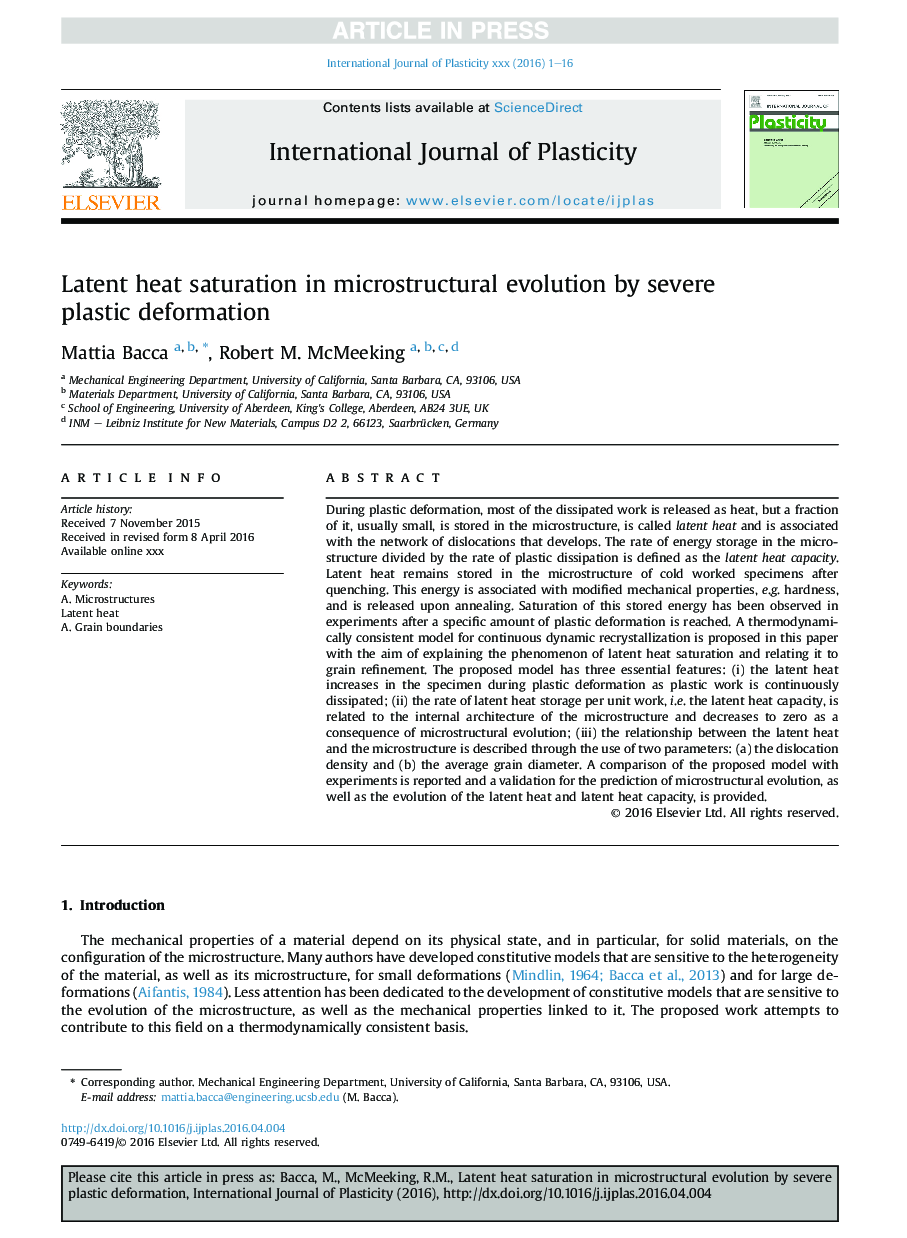| کد مقاله | کد نشریه | سال انتشار | مقاله انگلیسی | نسخه تمام متن |
|---|---|---|---|---|
| 7174896 | 1465590 | 2016 | 16 صفحه PDF | دانلود رایگان |
عنوان انگلیسی مقاله ISI
Latent heat saturation in microstructural evolution by severe plastic deformation
ترجمه فارسی عنوان
اشباع گرمایی خاموش در تکامل میکروساختار با تغییر شکل پلاستیک شدید
دانلود مقاله + سفارش ترجمه
دانلود مقاله ISI انگلیسی
رایگان برای ایرانیان
کلمات کلیدی
ترجمه چکیده
در طول تغییر شکل پلاستیک، اکثر کارهای منفعل به صورت گرما آزاد می شود، اما بخش کوچکی از آن، معمولا کوچک است، در ریزساختار نگهداری می شود، گرما نامنظم نامیده می شود و با شبکه جابجایی که توسعه می یابد، مرتبط است. میزان ذخیره انرژی در ریزساختار تقسیم بر میزان انتشار پلاستیکی به عنوان ظرفیت گرمای نهان تعریف شده است. گرمای خنثی در ریزساختار نمونه های سرمازدگی پس از خنک نگهداری می شود. این انرژی با خواص مکانیکی اصلاح شده است، به عنوان مثال سختی، و پس از آنلین آزاد می شود. اشباع این انرژی ذخیره شده در آزمایشات بعد از مقدار خاصی از تغییر شکل پلاستیک مشاهده شده است. در این مقاله یک مدل ترمودینامیکی سازگار برای تبدیل مجدد پویایی مداوم به منظور توضیح پدیده اشباع گرمای پنهان و ارتباط آن با پالایش دانه مطرح شده است. مدل پیشنهادی دارای سه ویژگی اساسی است: (1) گرمای پنهان در نمونه در طول تغییر شکل پلاستیک به عنوان کار پلاستیکی به طور مداوم دفع می شود؛ (2) میزان ذخیرۀ گرمای نهان در واحد کار، یعنی ظرفیت گرمای پنهان، مربوط به معماری داخلی ریزساختار می شود و به عنوان یک نتیجه از تکامل میکرو سازگار به صفر می رسد؛ (3) رابطه بین گرمای پنهان و ریزساختار با استفاده از دو پارامتر توصیف می شود: () تراکم جابجایی و (ب) قطر متوسط دانه. مقایسه مدل پیشنهاد شده با آزمایش گزارش شده است و اعتبار سنجی برای پیش بینی تکامل میکرو سازنده و همچنین تکامل گرمای پنهان و ظرفیت گرمای پنهان ارائه شده است.
موضوعات مرتبط
مهندسی و علوم پایه
سایر رشته های مهندسی
مهندسی مکانیک
چکیده انگلیسی
During plastic deformation, most of the dissipated work is released as heat, but a fraction of it, usually small, is stored in the microstructure, is called latent heat and is associated with the network of dislocations that develops. The rate of energy storage in the microstructure divided by the rate of plastic dissipation is defined as the latent heat capacity. Latent heat remains stored in the microstructure of cold worked specimens after quenching. This energy is associated with modified mechanical properties, e.g. hardness, and is released upon annealing. Saturation of this stored energy has been observed in experiments after a specific amount of plastic deformation is reached. A thermodynamically consistent model for continuous dynamic recrystallization is proposed in this paper with the aim of explaining the phenomenon of latent heat saturation and relating it to grain refinement. The proposed model has three essential features: (i) the latent heat increases in the specimen during plastic deformation as plastic work is continuously dissipated; (ii) the rate of latent heat storage per unit work, i.e. the latent heat capacity, is related to the internal architecture of the microstructure and decreases to zero as a consequence of microstructural evolution; (iii) the relationship between the latent heat and the microstructure is described through the use of two parameters: (a) the dislocation density and (b) the average grain diameter. A comparison of the proposed model with experiments is reported and a validation for the prediction of microstructural evolution, as well as the evolution of the latent heat and latent heat capacity, is provided.
ناشر
Database: Elsevier - ScienceDirect (ساینس دایرکت)
Journal: International Journal of Plasticity - Volume 83, August 2016, Pages 74-89
Journal: International Journal of Plasticity - Volume 83, August 2016, Pages 74-89
نویسندگان
Mattia Bacca, Robert M. McMeeking,
